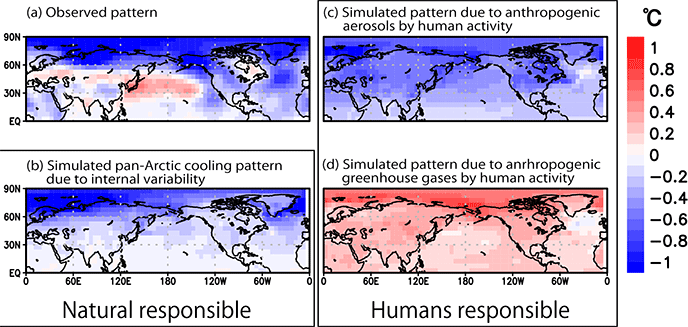National Institute of Polar Research
Humans and nature responsible for mid-20th century Arctic temperature changes
March 31 2022
The globe is warming, evidenced most clearly at the planet’s caps and, 97% of climate researchers agree, largely due to human-induced causes. But as human activities increased from roughly 1940 to 1970, the Arctic cooled. The temperature began to rise again in the early 1970s, leaving the Arctic anomaly question unanswered. What caused the cooling in opposition to the global surface air temperature increase over the 20th century?
A team based in the Japan Meteorological Agency’s Meteorological Research Institute may have finally answered the question. Through a comprehensive analysis of models and observations representing the internal variabilities of the Arctic climate and the external human-caused effects made over decades, the researchers found that the 1940-70 cooling was the result of both natural and human activity.
They published their results on Jan. 28 in Geophysical Research Letters.

30-yr change in 10-yr moving mean surface air temperature between 1970 and 1940. © Takuro Aizawa (NIPR)
“Long-term global warming has been extensively researched and has been primarily ascribed to anthropogenic greenhouse gas forcing,” said corresponding author Takuro Aizawa, project researcher with the National Institute of Polar Research and the Meteorological Research Institute of the Japan Meteorological Agency. “In this work, we used state-of-the-art climate models to conduct multimodel analyses and found that anthropogenic aerosol forcings and multidecadal internal variability were the components primarily contributing to the observed Arctic cooling.”
The Arctic’s surface air temperature (SAT) ebb and flows over the decades, with internal heat shifting through the climate system’s components of sea ice, ocean and atmosphere. This internal variability can lead to hotter and cooler periods, depending on which component is measured. Human-produced aerosols — which can block sunlight and cool the atmosphere — and greenhouse gas emissions — which trap heat and warm the atmosphere — can force the system’s temperatures to change further. Called forcing, this effect can also originate naturally through solar radiation and volcanic activity.
To better understand how internal variabilities, natural forcings and anthropogenic forcings contributed to the Arctic cooling, the researchers used multimodel data from the Coupled Model Intercomparison Project (CMIP). In its sixth phase, the project combines various models and observed data to produce a more complete understanding of the factors contributing to climate changes. Specifically, CMIP’s internal Detection and Attribution Model Intercomparison Project (DAMIP) focuses on clarifying natural versus human forcings since the Industrial Revolution. The researchers used 352 historical simulations from 35 global climate models to examine the evolution of historical Arctic SATs over the 20th century to test how different forcing combinations may affect Arctic temperature. They also used CMIP6/DAMIP data to assess stand-out events in the noisy datasets of several decades.
The data was processed down to the multimodel ensemble mean temperature, representing the change of SAT in response to external forcings.
“In our analysis, the rate of aerosol forcings is greater than the rate of greenhouse gas forcings, implying that the aerosol-induced cooling outweighed the greenhouse gas-induced warming,” Aizawa said, noting that the response to aerosol forcings varied from −1.9°C to 0.07°C in 1970, depending on the model.
The 1940-70 Arctic cooling period corresponds to increased anthropogenic sulfur emissions — producing sulfate aerosols — during the same period over Europe and North America. According to Aizawa, the composite analysis revealed an observable pattern of multidecadal cooling due to internal variability could occur once every 100 to 300 years, with fluctuations weaker than the observed data occurring every 70 years and stronger fluctuations occurring every 2000 years. It maps to the 1940-70 period and is comparable to the current Arctic warming that began in 1980.
“Anthropogenic sulfur emissions and sulfate aerosols will decrease in any future scenarios of shared socioeconomic pathways,” Aizawa said, explaining that aerosols, although bad for air quality, did offer a counterbalance mechanism as an atmospheric coolant. “The ongoing warming signal will override the fluctuations due to internal variabilities in the Arctic, leading to acceleration of the near-term future Arctic warming.”
Naga Oshima and Seiji Yukimoto, Meteorological Research Institute, Japan Meteorological Agency, oversee Aizawa and lead this research project.
Original article:
Journal: Geophysical Research Letters
Title: Contributions of Anthropogenic Aerosol Forcing and Multidecadal Internal Variability to Mid-20th Century Arctic Cooling—CMIP6/DAMIP Multimodel Analysis
Authors:
Takuro Aizawa (Meteorological Research Institute, Japan / Meteorological Agency, Japan / National Institute of Polar Research, Japan)
Naga Oshima (Meteorological Research Institute, Japan / Meteorological Agency, Japan)
Seiji Yukimoto (Meteorological Research Institute, Japan / Meteorological Agency, Japan)
DOI: 10.1029/2021GL097093
URL: https://doi.org/10.1029/2021GL097093
Available Online: February 28, 2022
Funder:
Arctic Challenge for Sustainability II (ArCS II), the Ministry of Education, Culture, Sports, Science and Technology, Integrated Research Program for advancing Climate Models (TOUGOU), the Ministry of Education, Culture, Sports, Science and Technology, a grant for the Global Environmental Research Coordination System from the Ministry of the Environment, Japan, the Environment Research and Technology Development Fund of the Environmental Restoration and Conservation Agency of Japan








